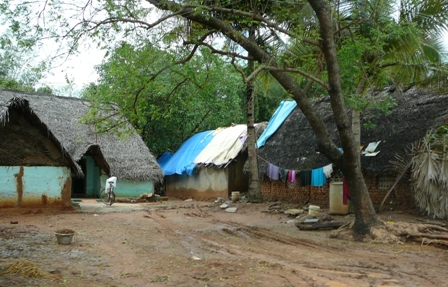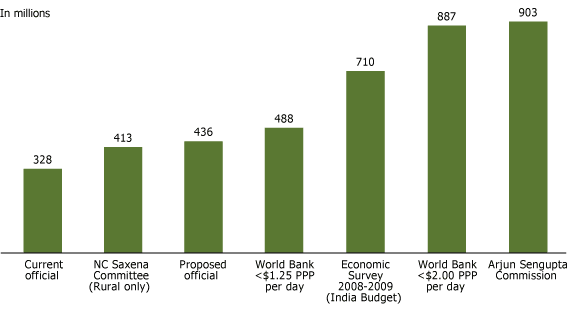Carl Haub
Former Demographer Emeritus

January 7, 2010
Former Demographer Emeritus
Former Deputy Director of Census Operations in India
(January 2010) Countries struggle with measuring their poverty populations, a figure that often determines the distribution of public assistance funds to those in need.
The World Bank estimates that 1.4 billion people live below an income of $1.25 per day and that 2.6 billion live below the $2 level worldwide.1 Deciding which of these figures represents “poverty” is left up to the individual. India is an example of the controversial nature of statistical estimates, although it is far from the only example in this controversy. Poverty measures in the United States are frequently criticized. India also serves as a good example since changes in the country’s poverty definition can add hundreds of millions to the global poverty population.
India’s official poverty measure has long been based solely upon the ability to purchase a minimum recommended daily diet of 2,400 kilocalories (kcal) in rural areas where about 70 percent of people live, and 2,100 kcal in urban areas. Rural areas usually have higher kcal requirements because of greater physical activity among rural residents. The National Planning Commission, which is responsible for the estimate, currently estimates that a monthly income of about Rs. 356 (about US$7.74) per person is needed to provide the required diet in rural areas and Rs. 539 in urban areas.2 Factors such as housing, health care, and transportation are not taken into account in the poverty estimates.

A typical rural village in Tamil Nadu state. The below poverty line is currently estimated to be 29 percent of rural India’s population. Photo: Carl Haub.
The estimate is derived from the National Sample Survey (NSS), which measures monthly per capita consumer expense (MPCE) every five years. The last such survey was held in 2004-2005 and the next is being conducted in 2009-2010. The Planning Commission’s estimates are significant since they are used to determine the official national and state level below poverty line (BPL) population. The BPL population is currently estimated at 29 percent in rural areas and 26 percent in urban areas. The BPL estimates set a rough ceiling on how many people are eligible for BPL identity cards, which provide some commodities at greatly reduced prices.3
The income amounts given above to estimate the BPL population have been ridiculed in the Indian press as “ridiculously low” and “astounding.”4 To address the issue, the Tendulkar Committee was set up in 2008 and reported its recommendations in November 2009. It proposed that the previous calorie requirement be eliminated and that national and state poverty lines be based on the current urban estimate of 26 percent. After adjustment, the rural poverty percentage was increased from 29 percent to 42 percent. The monetary cutoffs were raised to Rs. 447 of expenses a month for rural areas and Rs. 579 a month for urban areas. These new poverty lines also accounted for education and health needs. Although the direction of change was clearly correct, it was branded as “meager” by one researcher who pointed out that raising the rural daily minimum income from Rs. 12 to Rs. 15 alone added over 100 million to the BPL population.5 In addition, given the fact that the 2004-2005 NSS showed that 77 percent of the population had an average daily income of just Rs. 16, there are vast numbers barely above the poverty line who are nonetheless excluded from BPL benefits. The committee was also careful to point out that, despite the higher estimate of poverty, their analysis of past surveys showed that poverty had declined as the government had previously claimed.
In 2008, the Union (national) Rural Development Ministry set up a commission to examine alternative methods of estimating poverty. The commission reported its findings in late 2009. At the outset, the Commission felt that monetary amounts specified by the Planning Commission for a minimal diet were too low. Instead of Rs. 356 a month per person in rural areas, Rs. 700 was considered necessary (Rs. 1,000 in urban areas). The Commission recommended that the proportion of the rural population living below poverty be raised to at least 50 percent. But even that figure was achieved by lowering the rural kcal requirement to 2,100, the same as in urban areas, and adding a minimum monthly cereal consumption of 12.25 kilograms. If the 2,400 kcal criterion had been kept, the percentage of India’s rural population living in poverty would have risen to about 80 percent.
Two other Indian estimates are worth mentioning. The National Commission for Enterprises in the Unorganised Sector (NCEUS) was established in 2004 to examine ways to provide the welfare of that group. The unorganized sector comprises 86 percent of the Indian labor force and nearly always works below the daily minimum wage of Rs. 152 per day, have no benefits, pay no taxes, and often have little or no job security. Many are low-paid agricultural workers, workers in small manufacturing shops, or workers who deliver hazardous materials on bicycles. In its study, NCEUS set an overall minimum of Rs. 20 per day per person as its poverty cutoff and calculated that 77 percent of Indians live below poverty. The figure of Rs. 20 per day was cited in the Central Government’s Economic Survey 2008-2009, but in recalculating poverty based on the 2004-2005 NSS it estimated that 60.5 percent lived in poverty nationally—72 percent in rural areas and 32 percent in urban areas.
Various Estimates of the Number Living Below Poverty in India, 2009

Source: PRB, based on different recent estimates of the percent below poverty.
World Bank estimates are given in the figure above for comparative purposes. The World Bank estimates that 41.6 percent of India’s population lives below $1.25 per day and 75.6 percent live below $2 per day.
It is clear from the studies cited above that relatively minute changes in daily rupee cutoffs can add hundreds of millions of people to the poverty population. Thus, the official BPL figure currently used defines those living in truly abject poverty. The NCEUS, in its reports, noted that India’s recent economic growth had simply bypassed the vast majority of the population, benefitting a relative few. To the credit of the current national government, serious steps are being taken to reach the poor providing social security programs, increased education facilities, and local-level technical training.
All of these wildly varying figures aside, what does poverty in India actually mean? It is difficult for those living in an industrialized country to truly appreciate the level of poverty in the country. In the West, even those living in poverty can live in well-constructed dwellings, with heating, clean running water, indoor toilet facilities, access to health care, and even a vehicle. Such luxuries, to use a common Indian expression, are but a “distant dream” to India’s poor.
Carl Haub is senior demographer at PRB. O.P Sharma is a PRB consultant in India.
